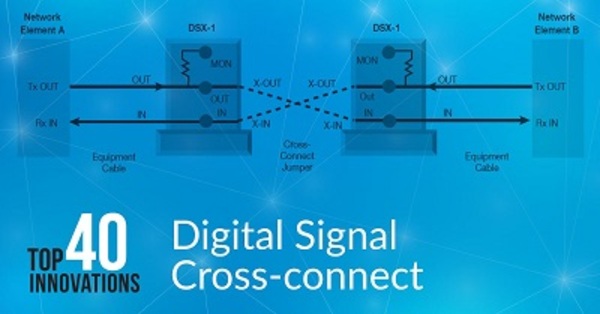
We continue today with our unveiling of innovations—in alphabetical order—that are ranked 11-20. You can see a list of the Top 40 innovations already revealed on our 40th anniversary page. As our 40th anniversary year draws to a close, we hope you enjoy looking back at what we think are our top innovations—ones that have helped build the world’s infrastructure of today and tomorrow.
Have an opinion about or connection to any of the innovations? Leave a comment below.
CommScope’s Top 40 Innovations—Grouping 11-20
The Digital Signal Cross-Connect (DSX)
Definition: The Digital Signal Cross-Connect, or DSX, is a value-added product based on expertise making telephone jacks, a core competency of what was then ADC Telecommunications.
Year of the Innovation: 1985
What is the innovation that CommScope or one of its acquired companies was first in creating?
In 1985, ADC (now part of CommScope) refreshed Digital Signal Cross-Connect. For the greater part of two decades following the breakup of the Bell System in 1984, the many variations of this product line were the growth engine of ADC. ADC became the leading supplier of DSX to the telecommunications industry and the experience gained in cable management led to the development of the fiber optic products which comprise a significant portion of CommScope’s business today.
What was happening in the market that this innovation was needed?
The previous decades ushered in technological advancement in all areas of telecommunications and data processing. Public and private computer use increased, and telecommunications evolved into the computer age, with telephonic digital transmission and the expansion of data communications. Telecommunications networks needed to be designed to seamlessly absorb new growth, accommodate wiring changes, and restore failed circuits quickly. Telecommunications companies needed a method to easily reconfigure networks.
How did this innovation benefit customers and the industry?
ADC pioneered an industry standard to access and cross-connect digital telephony circuits. Previously, when reconfiguring networks, operators had to locate cables and put them in new locations, resulting in extensive, intrusive reengineering requiring a great deal of time and money. Connectivity typically accounts for up to 10 percent of the upfront costs of network deployment.
In contrast, DSX provides a quick solution for maintaining service even during massive redesigns. Operators simply remove and replace a wire or coaxial plug on its cross-connect field to reroute circuits.
This innovative product was an amalgam of miniaturized components, which was especially important in dense urban places like New York City and Chicago where real estate was expensive, and became standard for telephone circuit access and patching.
Did this innovation act as the springboard for other innovations and, if so, how do they all tie together?
DSX enabled ADC to leverage its most significant innovation, the Bantam jack. This innovative twisted pair product made ADC the clear market leader, acting as a springboard to similar coaxial DSX products for higher data rate transmission while paving the way for investment in fiber optic technology.
What is the significance of the innovation for CommScope?
With its DSX innovation, CommScope and its acquired companies created a course for the next millennium, focusing on being a total solutions provider for the last mile.
Related links:







